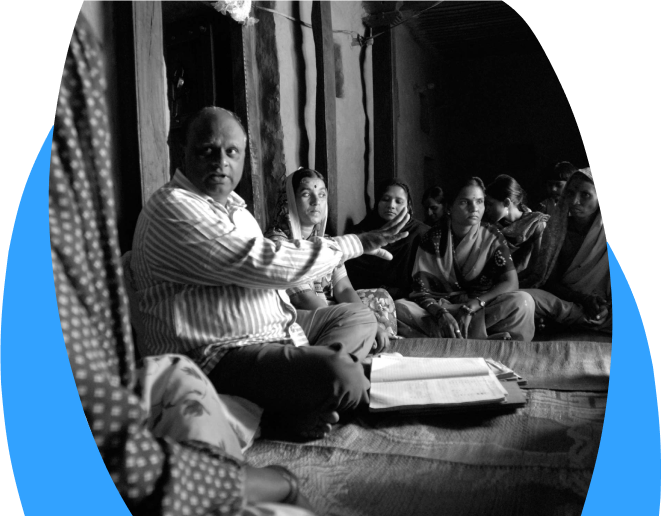Reports, Journals, and Conferences
HMF prepares individual project reports, which are submitted annually to respective donors and agencies.
HMF’s work has been presented at over 30 conferences throughout the world. These presentations have covered the village health worker model, sustainable farming efforts, self-help groups and women empowerment programmes, pregnancy and religious fasting, HIV transmission during pregnancy, domestic violence prevention and counselling centre, prevention of domestic violence through the engagement of men and many more.
Published journal papers/reports are outlined below. Some of these projects were supported by HMF, and in some cases HMF current/former staff members were involved at the time of manuscript preparation and publications.
1. Hayter M, Lee A, Dixit A, Rasalpurkar S, Fewings H, Ali P, Whitfield C, Giridhari S, Kabra P, Rayamane K, Ovseiko P, Ahankari A. Experiences of domestic violence prevention interventions and gender equality promotion work: a qualitative study of Nirdhar Groups in rural India. F1000Research 2023. doi: 10.12688/f1000research.131468.1
2. Ahankari AS, Tata LJ, Fogarty AW. Access to a piped water supply is positively associated with haemoglobin levels in females living in rural Maharashtra State, India. Public Health 2021. doi: 10.1016/j.puhe.2021.09.030.
3. Ahankari AS, Kabra P, Tata LJ et al. Two measures of systemic inflammation are positively associated with haemoglobin levels in adolescent girls living in rural India: A cross‐sectional study. Tropical Medicine & International Health 2021. doi:10.1111/tmi.13524.
4. Ahankari AS, Tata LJ, Fogarty AW. Weight, height, and midupper arm circumference are associated with haemoglobin levels in adolescent girls living in rural India: A cross‐sectional study. Maternal and Child Nutrition 2020. doi:10.1111/mcn.12908.
5. Ahankari A, Hayter M, Whitfield C et al. aDolescents gEnder surVey, rEsponsible coupLes evaluatiOn, and capacity building Project in India (DEVELOP): a study protocol. F1000Research 2019. doi:10.12688/f1000research.19521.1.
6. Ahankari AS, Myles PR, Dixit JV et al. Consanguinity is a risk factor for maternal anaemia and low birth weight in pregnant women living in rural India: A prospective study. Public Health 2017. doi: 10.1016/j.puhe.2017.06.023. 2.
7. Ahankari AS, Myles PR, Tsang S et al. A qualitative study exploring clinical reasoning for influenza-like illness in Solapur city, Maharashtra, India. Anthropology and Medicine 2017. doi: 10.1080/13648470.2017.1321459.
8. Dave M, Ahankari AS, Myles PR et al. Household air pollution and lung function in Indian adults: a cross-sectional study. Int J of Tuberculosis and Lung Disease 2017. doi: 10.5588/ijtld.16.0615.
9. Adaji EE, Ahankari AS, Myles PR. An investigation to identify potential risk factors associated with common chronic diseases among the older population in India. Indian J Community Medicine 2017.doi:10.4103/0970-0218.199802.
10. Ahankari AS, Bapat S, Myles PR et al. Factors associated with pre-term delivery and low birth weight: a study from rural Maharashtra, India. F1000Research 2017. doi: 10.12688/f1000research.10556.1.
11. Ahankari AS, Fogarty AW, Tata LJ et al. Healthcare benefits linked with below poverty line registration in India: Observations from Maharashtra Anaemia (MAS) Study. F1000Research 2017. doi: 10.12688/f1000research.10556.1.
12. Ahankari AS, Myles PR, Tata LJ et al. PCPNDT seems to benefit India’s birth sex ratios. BMJ 2016. doi: 10.1136/bmj.i5194.
13. Ahankari AS, Myles PR, Fogarty AW et al. Prevalence of iron deficiency anaemia and risk factors in 1,010 adolescent girls from rural Maharashtra, India: a cross-sectional survey. Public Health 2016. doi: 10.1016/j.puhe.2016.07.010.
14. Ahankari AS, Dixit JV, Fogarty AW et al. Comparison of the NBM 200 non-invasive haemoglobin sensor with Sahli’s hemometer among adolescent girls in rural India. BMJ Innovations 2016. doi: 10.1136/bmjinnov-2015-000139.
15. Ahankari AS, Fogarty AW, Tata LJ et al. Assessment of a non-invasive haemoglobin sensor NBM 200 among pregnant women in rural India. BMJ Innovations 2016. doi: 10.1136/bmjinnov-2015-000085.
16. Ahankari AS, Myles PR, Tata LJ et al. Banning of fetal sex determination and changes in sex ratio in India. Lancet Global Health 2015. doi: 10.1016/S2214-109X(15)00053-4.
17. Ahankari AS, Fogarty A. Association of Socioeconomic status with sex ratio at live birth in Individuals living in the slums of Sholapur city, India. Int J Med Sci Pub Health 2015. doi:10.5455/ijmsph.2015.1109201428.
Training manuals
1. Ahankari AS. Contribution in the capacity of lead investigator and project manager on DEVELOP 2 GCRF grant. Three gender equality training manuals were developed comprising of 650 pages in Marathi language (Maharashtra state of India); (a) for boys and men, (b) girls and women, and (c) project staff to implement gender equality related work. Five videos were developed to educate communities on the importance of gender equality. These are currently used by four NGOs to implement gender equality projects across 100 villages in India (funded by SWISSAID, Switzerland through European Union Grant).
2. Ahankari A (Eds). Life free from violence: training manual for village-based dispute resolution committee members. Halo Medical Foundation, 3rd Edition. June 2014.
3. Dixit JV, Ahankari AS. Maternal and neonatal health training manual for grass root health workers. Halo Medical Foundation, India. April 2013.
4. Dixit JV, Ahankari AS. Adolescent health dialogue booklet. Halo Medical Foundation, India. April 2013.
